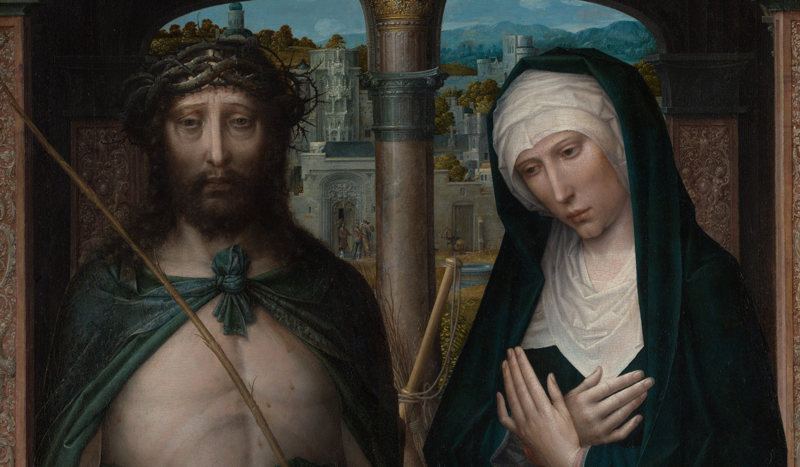
Christ Crowned with Thorns (Ecce Homo), and the Mourning Virgin (Mater Dolorosa) Adriaen Isenbrant Netherlandish ca. 1530–40
Seeing a loved one suffer can be an excruciating experience, but also an opportunity to join with the Blessed Virgin as she entered into her Son’s suffering and death.
That’s counsel from Catholic psychiatrist Dr. Aaron Kheriaty, who invites us this Holy Week to “reflect on Mary’s participation in the Cross of Christ as a model for how each of us can more fully enter into Christ’s suffering, and in doing so, grow in union with Him.”
Readers of Catholic Exchange have been able to follow Kheriaty’s Lenten series on the meaning of suffering. The series reaches its culmination this week – the holiest of the Catholic calendar – as the author reaches out to those struggling as they witness the suffering of their loved ones.
“As a psychiatrist, I have learned that one of the most difficult forms of suffering we encounter is the helpless experience of seeing a loved one suffer,” Kheriaty observes. “Mary watched her Son suffer His Passion without being able to prevent that unspeakable horror. Despite her elevated status as the Mother of God, Our Lady was not spared suffering. But rather than begrudgingly enduring it, she embraced it for love of her Son.”
Mary’s “participation” in Jesus’ cross, Kheriaty explains, began before her Son was born. When we celebrate the feast of the Annunciation, we remember that Mary gave “her unconditional ‘yes’ to God’s divine plan,” including the suffering of Christ.
“From the first moment of the Incarnation, when Christ became a vulnerable human embryo in his Mother’s womb, the sign of the Cross was imprinted on Jesus’ entire life—and therefore, on His Mother’s entire life as well,” he writes. “Our Lord was born from the Cross and died on the Cross.”
While Christians may perceive Holy Week and Christmas week as two entirely different celebrations, Kheriaty observes that “the Cross is not just found on Calvary; it’s found in the Nativity, and in all the moments of Christ’s life in between.”
“The tender and beautiful love of Jesus in the manger is no different than the tender and beautiful love of Jesus on the Cross,” he notes.
When Jesus was older and was found missing, Mary had no “crystal ball telling her to wait three days and then go and find Him in the Temple,” Kheriaty points out. “She placed everything—her hopes and her fears, her faith and her trust, her lack of knowledge or possessions or even a clear plan—entirely in God’s hands.”
“Later, when her Son was grown, she stood fast, without outrage or complaint, as Jesus endured a farcical trial and unjust sentencing,” Kheriaty continues. “She witnessed His unspeakably brutal scourging, saw His sacred head crowned with thorns, watched Him carry the Cross, and ultimately, stood by Him as He was crucified. When she stood weeping at the foot of the Cross, and later held His lifeless and battered body, she did not know that in three days He would rise from the dead. She endured all this in faith, trusting in God’s plan without fully comprehending it.”
Beyond her Son’s crucifixion and Resurrection, Kheriaty notes Mary “continued to carry the Cross of Christ in her Immaculate Heart” even after His Ascension into Heaven.
“She still had to carry on with her life on earth, without his physical presence (save for his hidden presence in the Eucharist), until He finally called her home and crowned her Queen of Heaven,” he observes.
“This is the mystery of our participation in the Cross of Christ. The most powerful antidote to our suffering comes not when we focus on our own pain, but when we ask Jesus to teach us His—when we learn His suffering as Our Lady did.”
Kheriaty has shared some of his own struggles in his writing.
In his first piece of his Lenten series, he taught his readers the simple prayer: doce me passionem Tuam – or, “teach me Your suffering.”
He explained that a five-year struggle of his own with a chronic pain condition ultimately led him to look to Jesus’ cross.
“I wanted very badly to understand my suffering, more than I wanted to understand Our Lord’s,” he recalled. “It took a long time before I discovered that meditating on Christ’s wounds was far more fruitful than contemplating my own. I was slow and stubborn, and I wish I would have learned sooner to turn my attention to Christ’s Cross rather than focusing on mine.”
Kheriaty has been no stranger to suffering in his professional life as well.
A former professor of psychiatry for 15 years at the University of California, Irvine, (UCI) School of Medicine – where he also served as director of UCI Health’s medical ethics program – Kheriaty was fired in December 2021 after refusing to take the COVID-19 shot.
In his column “Human Flourishing,” he agonized over his medical field’s acquiescence to the COVID shot mandates forced on Americans by the government/pharma/tech complex that seized control after the outbreak of COVID-19.
“Two years ago I never could have imagined that the University would dismiss me and other doctors, nurses, faculty, staff, and students for this arbitrary and capricious reason,” he wrote. “I want to share a bit of my story, not because I am unique but simply because my experience is representative of what many others—who do not necessarily have a public voice—have experienced since these mandates went into effect.”
Focusing on Christ’s cross, he explained, allows our sufferings to “ebb, when we become unburdened by them.”
“That is where true freedom is found,” he added, noting as well that “Our Lord does want to heal us; He does want to alleviate our suffering. He does that through His own Cross: by His stripes we are healed (Is. 53:5).”
